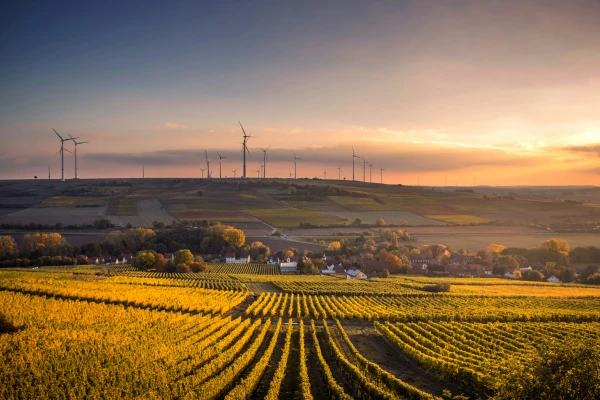Our Views
Sustainable agriculture: definition, advantages and policies
In a world grappling with the challenges of climate change, dwindling natural resources, and a surging global population, the need for sustainable agriculture has never been more pressing. Sustainable agriculture offers a lifeline - a way to feed the world's billions while preserving our planet for generations to come.
Index:
1. Definition: What is Sustainable Agriculture?
2. Importance of Sustainable Agriculture
3. Advantages and Benefits of Sustainable Agriculture
4. Disadvantages and Problems of Sustainable Agriculture
5. Types of Sustainable Agriculture
6. Sustainable Agriculture Practices and Methods
7. Public Policies for Sustainable Agriculture: Examples
8. How to Promote Sustainable Agriculture
9. Conclusion: A Brighter and More Sustainable Future
Let's start by explaining what sustainable agriculture is.
1. Definition: What is Sustainable Agriculture?
Sustainable agriculture isn't just a farming method; it's a commitment to the present and future well-being of our planet and all its inhabitants. At its core, sustainable agriculture represents a harmonious marriage between traditional farming wisdom and modern scientific innovation, all in the name of environmental, social, and economic sustainability.
In the simplest terms, sustainable agriculture refers to a set of farming practices that aim to meet our current needs without compromising the ability of future generations to meet theirs. This definition, however, only scratches the surface of what sustainable agriculture entails. To truly grasp its essence, we must explore its three interconnected pillars: ecological sustainability, economic sustainability, and social sustainability.
1.1 Ecological Sustainability
Ecological sustainability forms the foundation of sustainable agriculture. It recognizes that our environment and the health of the planet are inextricably linked to the health of our food systems. Sustainable farming practices prioritize soil health, biodiversity, and resource conservation. These practices include:
- Crop Rotation: The systematic planting of different crops in a specific order to improve soil quality and disrupt pest cycles.
- No-Till Farming: The cultivation of crops without plowing, reducing soil erosion and preserving soil structure.
- Agroforestry: Integrating trees and other woody plants into farming systems to improve land use, conserve biodiversity, and provide additional income sources.
Ecological sustainability also encompasses organic farming, which avoids synthetic pesticides and fertilizers, promoting natural alternatives to protect both the environment and consumers' health.
1.2 Economic Sustainability
Sustainable agriculture recognizes that farmers are at the heart of food production. Economic sustainability ensures that farmers can make a living while practicing environmentally responsible farming. It emphasizes the importance of:
- Reduced Input Costs: Sustainable practices often lead to a reduction in costly chemical inputs, improving farmers' bottom lines.
- Market Resilience: By diversifying crops and adopting sustainable methods, farmers become more resilient to market fluctuations.
- Support for Smallholders: Economic sustainability includes efforts to support small-scale farmers and promote equitable access to resources.
1.3 Social Sustainability
Social sustainability extends the benefits of sustainable agriculture to entire communities. It focuses on ensuring that farming practices respect human rights, support rural livelihoods, and enhance the well-being of those involved in food production. Key aspects of social sustainability include:
- Fair Wages: Ensuring fair compensation for agricultural labor, preventing exploitation and promoting dignity in the workforce.
- Community Engagement: Encouraging community involvement and decision-making in farming and food systems.
- Food Security: Sustainable agriculture plays a pivotal role in guaranteeing access to safe, nutritious food for everyone.
In conclusion, sustainable agriculture is not merely a concept; it is a call to action. It encompasses practices that protect the environment, promote economic viability, and advance social equity. It is a vision for the future in which food is not only abundant but also produced and distributed in a way that respects the delicate balance of our planet and the rights of all its inhabitants.
2. Importance of Sustainable Agriculture
As the world faces a growing list of environmental challenges and a burgeoning global population, the significance of sustainable agriculture cannot be overstated. It stands as a beacon of hope and a practical solution to address multiple pressing issues. Let's explore why sustainable agriculture is of paramount importance:
2.1 Food Security
Sustainable agriculture is an essential pillar of global food security. With the global population projected to reach nearly 10 billion by 2050, the demand for food is on an upward trajectory. Sustainable farming practices are critical to ensure a consistent and secure food supply.
Through crop rotation, organic farming, and other sustainable methods, farmers can increase crop yields over time. This not only meets the immediate need for food but also helps build resilience in agriculture against the unpredictability of climate change.
2.2 Environmental Protection
The environment is intricately tied to the health of our food systems. Unsustainable agricultural practices, such as heavy pesticide and chemical fertilizer use, monoculture farming, and excessive irrigation, have contributed to soil degradation, water pollution, and loss of biodiversity.
Sustainable agriculture, on the other hand, mitigates these issues. It protects soil health, reduces the need for harmful chemical inputs, and promotes biodiversity. Through practices like agroforestry and no-till farming, sustainable agriculture is an effective guardian of the environment.
2.3 Climate Change Mitigation
As climate change becomes an ever-pressing global concern, sustainable agriculture plays a significant role in mitigating its effects. Sustainable farming practices sequester carbon in the soil, reducing greenhouse gas emissions. This helps combat climate change by locking away carbon and reducing its atmospheric concentration.
Agroforestry, in particular, is a champion in the fight against climate change. By integrating trees into farming systems, it sequesters carbon in woody biomass and in the soil, making it a powerful tool for climate change mitigation.
In a world where climate change threatens agriculture and the well-being of communities, sustainable agriculture offers a way to adapt to new climate realities while reducing the sector's contribution to global warming.
2.4 Resource Efficiency
Sustainable agriculture is synonymous with resource efficiency. It emphasizes the responsible use of resources such as water, energy, and arable land. Techniques like water-efficient irrigation, where water is applied directly to the plant root zone, limit wastage and ensure that water is used responsibly.
Additionally, sustainable agriculture often encourages the use of renewable energy sources and minimizes waste in the farming process. This not only reduces environmental impact but also contributes to economic sustainability by cutting input costs.
2.5 Preservation of Ecosystems
Our planet is home to diverse ecosystems that are essential for life on Earth. Sustainable agriculture recognizes the importance of these ecosystems and seeks to work in harmony with them.
Agroecological practices, including integrated pest management and polyculture (the cultivation of multiple crops in close proximity), preserve ecosystems by reducing the need for harmful chemicals. These practices promote biodiversity, protect pollinators, and maintain a healthy balance in the natural world.
The importance of sustainable agriculture reaches beyond mere sustenance; it touches every facet of our lives. It ensures food security, protects the environment, mitigates climate change, promotes resource efficiency, and preserves the delicate ecosystems upon which we all depend.
3. Advantages and Benefits of Sustainable Agriculture
Sustainable agriculture offers a host of advantages and benefits that extend far beyond the confines of the farm. These benefits range from improving crop yields to safeguarding the environment and fostering economic resilience. Let's delve into the many advantages and benefits that sustainable agriculture brings to the table:
3.1 Enhanced Crop Yields
Sustainable agriculture practices have proven time and again to enhance crop yields. Techniques such as crop rotation, organic farming, and agroforestry lead to healthier and more fertile soil, which, in turn, produces higher yields of crops. While the benefits of these practices may not be immediate, they accumulate over time, resulting in consistently bountiful harvests.
3.2 Improved Soil Health
Soil is the lifeblood of agriculture, and sustainable practices prioritize its health. Crop rotation, organic farming, and no-till farming all contribute to better soil quality. Crop rotation helps break pest and disease cycles, while organic farming fosters a biologically active and nutrient-rich soil. No-till farming prevents soil erosion, maintains soil structure, and reduces soil compaction, which can inhibit plant root growth.
3.3 Economic Resilience
In an era of volatile markets and unpredictable weather patterns, economic resilience is a key advantage of sustainable agriculture. Sustainable practices reduce dependence on costly chemical inputs, which can lead to significant cost savings for farmers. Additionally, diversified crops and sustainable methods make farmers more resilient to market fluctuations. They are less vulnerable to the ups and downs of commodity prices, providing stability in an uncertain agricultural landscape.
3.4 Reduced Environmental Impact
Sustainable agriculture has a marked impact on reducing the environmental footprint of food production. By reducing the use of synthetic pesticides, chemical fertilizers, and other harmful inputs, it minimizes the negative effects on the environment. This leads to less contamination of water bodies, lower greenhouse gas emissions, and protection of biodiversity.
3.5 Soil Carbon Sequestration
As the world grapples with the challenges of climate change, sustainable agriculture emerges as a valuable tool in the fight against global warming. Practices like agroforestry and no-till farming sequester carbon in the soil. This means they capture and store atmospheric carbon dioxide in plants and soil, reducing its concentration in the atmosphere and mitigating the effects of climate change.
3.6 Improved Water Management
Sustainable agriculture also contributes to better water management. Techniques such as water-efficient irrigation methods ensure that water is used responsibly and efficiently. They reduce water wastage and help in the preservation of this precious resource.
3.7 Biodiversity Conservation
Promoting biodiversity is another hallmark of sustainable agriculture. Integrated pest management (IPM) and agroecological practices protect and enhance biodiversity by reducing the need for harmful chemicals. This, in turn, safeguards important pollinators and other vital components of ecosystems.
3.8 Healthier, Safer Food
Organic farming, a subset of sustainable agriculture, prioritizes the health and safety of consumers. By avoiding synthetic pesticides and chemical fertilizers, organic farming produces food with lower residues of harmful substances. This not only benefits consumers but also promotes healthier ecosystems and farmworkers.
The advantages and benefits of sustainable agriculture are vast and far-reaching. From bolstering crop yields to protecting the environment and enhancing economic resilience, sustainable farming practices offer a path to a brighter and more sustainable future.
4. Disadvantages and Problems of Sustainable Agriculture
While sustainable agriculture holds immense promise, it's not without its challenges and drawbacks. It's important to recognize these issues to ensure a balanced perspective. Let's explore some of the disadvantages and problems associated with sustainable agriculture:
4.1 Transition Period
One of the primary challenges in adopting sustainable agriculture practices is the transition period. Shifting from conventional, high-input farming to sustainable methods can be disruptive and time-consuming. Farmers may need to invest in new equipment, adapt to different techniques, and undergo training. This transition phase can lead to temporary setbacks in terms of yields and income.
4.2 Initial Cost
Sustainable agriculture often requires an upfront investment in new practices, technologies, or equipment. For some farmers, particularly smallholders with limited resources, these initial costs can be a significant barrier to entry.
4.3 Yield Variations
While sustainable agriculture is generally associated with improved yields over the long term, there can be short-term variations. Farmers may experience fluctuations in yields as they adapt to new practices and ecological systems. These fluctuations can be a source of concern for farmers who rely on consistent income.
4.4 Knowledge and Education
To successfully practice sustainable agriculture, farmers need access to knowledge and education about sustainable methods. Providing this education and training can be a challenge, especially in remote or underserved regions where agricultural extension services may be limited.
4.5 Limited Availability of Organic Inputs
In organic farming, the limited availability of organic inputs such as organic fertilizers and pesticides can pose challenges. These inputs can be more expensive and may not be readily accessible in all regions.
4.6 Market Demand and Certification
In organic and sustainable agriculture, the market demand for certified products is growing. However, obtaining and maintaining certification can be a complex and costly process, which can be a barrier for some farmers. Market fluctuations and access to premium markets for sustainable products can also be challenges.
4.7 Pest and Disease Management
Sustainable agriculture often relies on integrated pest management (IPM) and other non-chemical methods to control pests and diseases. While these approaches can be effective, they may require careful monitoring and consistent management, which can be labor-intensive.
4.8 Limited Suitability for Certain Crops or Regions
Some sustainable agriculture practices may not be suitable for all crops or regions. For example, crop rotation and certain organic methods may be better suited to certain types of crops or climates, limiting their applicability in diverse agricultural settings.
While sustainable agriculture is a powerful approach with numerous benefits, it is essential to acknowledge the challenges and potential drawbacks. The transition period, initial costs, and variations in yields can be stumbling blocks for some farmers. However, with the right support, education, and incentives, many of these challenges can be addressed and overcome.
5. Types of Sustainable Agriculture
Sustainable agriculture is not a one-size-fits-all concept. It encompasses a diverse array of approaches and practices tailored to different regions, climates, and agricultural needs. These various types of sustainable agriculture reflect the adaptability of the concept to meet the unique challenges and opportunities of different agricultural systems. Let's explore some of the prominent types of sustainable agriculture:
5.1 Organic Farming
Organic farming is perhaps the most widely recognized form of sustainable agriculture. It relies on practices that avoid synthetic pesticides and chemical fertilizers, emphasizing natural alternatives for pest management and soil enrichment. Organic farming also typically promotes crop rotation, cover cropping, and the preservation of biodiversity.
Organic certification ensures that products meet specific organic standards, assuring consumers that they are purchasing sustainably grown, chemical-free food. Organic farming is known for producing healthier and safer food while promoting environmental sustainability.
5.2 Permaculture
Permaculture is a design system that mimics natural ecosystems to create sustainable and self-sufficient food production systems. Permaculture principles encourage the use of synergistic plant combinations, efficient water management, and the integration of animals and plants. It's a holistic approach that aims to minimize waste, promote resilience, and create sustainable ecosystems.
5.3 Agroforestry
Agroforestry combines traditional agriculture with the cultivation of trees and woody plants. By integrating trees into farming systems, agroforestry offers multiple benefits, including enhanced soil fertility, improved water management, and the conservation of biodiversity. This approach recognizes the importance of both annual and perennial crops, allowing farmers to maximize land use and productivity.
5.4 No-Till Farming
No-till farming is a practice that avoids the plowing of fields, leaving crop residue on the surface to protect the soil from erosion. By retaining organic matter and soil structure, no-till farming helps preserve soil health, minimize disturbance to the ecosystem, and reduce carbon emissions. This method is particularly beneficial in regions prone to soil erosion.
5.5 Biodynamic Farming
Biodynamic farming takes organic farming a step further by incorporating holistic practices based on the work of Rudolf Steiner. It includes planting, cultivating, and harvesting based on lunar and astrological cycles. Biodynamic farming also emphasizes self-sufficiency and closed-loop systems, where farms generate their compost and fertility.
5.6 Conservation Agriculture
Conservation agriculture focuses on minimal soil disturbance, crop rotation, and maintaining crop residue on the soil surface. This approach is especially important for regions with arid or semiarid climates, as it conserves water and promotes soil health.
5.7 Sustainable Intensification
Sustainable intensification aims to increase agricultural productivity while reducing environmental impacts. It combines elements of various sustainable practices to enhance crop yields, protect the environment, and support food security. This approach recognizes that increased food production is necessary to meet growing global demand.
The diversity of sustainable agriculture methods underscores its adaptability to a wide range of farming systems. Whether through organic farming, permaculture, agroforestry, or other approaches, sustainable agriculture offers flexibility in addressing the unique challenges and opportunities faced by different agricultural regions and climates.
6. Sustainable Agriculture Practices and Methods
The success of sustainable agriculture hinges on the practical application of a wide range of practices and methods. These techniques not only enhance agricultural productivity but also promote environmental stewardship and social well-being. Let's explore some of the key sustainable agriculture practices and methods that drive this transformative approach:
6.1 Crop Rotation
Crop rotation is a fundamental practice in sustainable agriculture. It involves the systematic planting of different crops in a specific order in the same field over successive seasons. This method helps break pest and disease cycles, improves soil fertility, and minimizes soil degradation. By diversifying crops, farmers can also enhance yields and reduce the need for synthetic inputs.
6.2 Integrated Pest Management (IPM)
Integrated Pest Management is a science-based approach to managing pests, diseases, and weeds. It combines various strategies, including biological control, cultural practices, and the targeted use of pesticides when necessary. IPM minimizes the reliance on harmful chemicals, reducing the environmental impact and protecting beneficial organisms.
6.3 Cover Cropping
Cover cropping involves planting specific crops during fallow periods or in between cash crops. These cover crops protect the soil from erosion, improve soil structure, and add nutrients through natural decomposition. Cover cropping is essential for maintaining soil health and preventing the loss of valuable topsoil.
6.4 Conservation Tillage
Conservation tillage practices minimize soil disturbance, preserving soil structure and organic matter. No-till and reduced-till methods avoid traditional plowing and are effective in reducing soil erosion, conserving water, and mitigating carbon emissions. These practices are especially valuable in regions prone to soil erosion.
6.5 Agroecology
Agroecology is a holistic approach that merges ecological principles with agricultural practices. It emphasizes the integration of diverse crops and livestock, mimicking natural ecosystems to promote sustainability. By fostering natural processes and biodiversity, agroecology protects the environment while improving crop yields and overall farm resilience.
6.6 Polyculture
Polyculture involves the cultivation of multiple crops in close proximity, as opposed to monoculture (the cultivation of a single crop). Polyculture mimics natural ecosystems and promotes biodiversity. It also minimizes the risk of crop failure due to pests or diseases that target specific plant species. This practice improves soil health, reduces the need for chemical inputs, and increases crop resilience.
6.7 Water-Efficient Irrigation
Efficient water management is integral to sustainable agriculture. Water-efficient irrigation methods, such as drip irrigation and precision farming, ensure that water is applied directly to the plant root zone, reducing water wastage. These practices help conserve water resources and promote responsible water use.
6.8 Nutrient Management
Balanced nutrient management is essential for both soil health and environmental protection. Sustainable agriculture emphasizes the judicious use of organic and synthetic fertilizers. By matching nutrient application to crop needs and timing it correctly, farmers can reduce nutrient runoff, which can lead to water pollution.
7. Public Policies for Sustainable Agriculture: Examples
Public policies play a pivotal role in shaping the landscape of sustainable agriculture. Governments and international organizations have recognized the importance of sustainable farming practices in addressing pressing global challenges. To facilitate the transition to more sustainable food systems, various policies and initiatives have been put in place. Let's explore some notable examples of public policies that promote sustainable agriculture:
7.1 Subsidies and Incentives
Many governments provide financial incentives and subsidies to farmers who adopt sustainable practices. These incentives can take various forms, including financial support for purchasing equipment, organic certification, or transitioning to sustainable methods. Subsidies for sustainable agriculture not only encourage the adoption of environmentally friendly practices but also promote economic sustainability for farmers.
7.2 Conservation Programs
Conservation programs focus on preserving natural resources and promoting sustainable land management. They often offer financial incentives to farmers who implement conservation practices such as cover cropping, agroforestry, and no-till farming. These programs help protect soil, water, and wildlife habitats while improving agricultural sustainability.
7.3 Agri-Environmental Schemes
Agri-environmental schemes are comprehensive programs that encourage environmentally responsible farming practices. Farmers receive compensation for adopting practices that enhance biodiversity, reduce the use of chemicals, and protect water resources. These schemes are crucial for preserving ecosystems while ensuring the economic viability of agriculture.
7.4 Sustainable Farming Standards
Sustainable agriculture standards and certifications, such as USDA Organic, EU Organic, and Fair Trade, are often linked to public policies. Governments support these certifications through regulations and compliance mechanisms. They ensure that consumers can trust the sustainability and quality of products while providing market access for sustainable farmers.
7.5 Environmental Regulations
Environmental regulations establish limits on practices that can harm the environment. These regulations may restrict the use of certain pesticides, set water quality standards, or establish rules for soil conservation. By enforcing these regulations, governments help safeguard natural resources and ecosystems.
7.6 Research and Extension Services
Governments often fund agricultural research and extension services that promote sustainable practices. Research provides evidence-based insights, and extension services disseminate knowledge to farmers. These initiatives contribute to the continuous development and adoption of sustainable methods.
7.7 Land Use Planning
Land use planning involves the careful allocation of land for various uses, including agriculture. By integrating sustainability principles into land use planning, governments can protect valuable agricultural land, reduce urban sprawl, and maintain green spaces. This approach helps secure land for future generations and supports sustainable agriculture.
8. How to Promote Sustainable Agriculture
Promoting sustainable agriculture is a collective endeavor that involves individuals, communities, organizations, and governments. To realize the promise of sustainable farming practices, proactive steps and strategies are essential. Let's explore how we can actively promote and support sustainable agriculture:
8.1 Support Local Farmers
One of the most effective ways to promote sustainable agriculture is to support local farmers who prioritize environmentally responsible and sustainable farming practices. When you buy produce and products from local farmers, you're encouraging the adoption of sustainable methods. This support helps maintain local food systems, reduce food miles, and strengthen the resilience of your community's agriculture.
8.2 Advocate for Policy Change
Advocacy for policy change is a powerful tool in promoting sustainable agriculture. Get involved in local and national advocacy efforts to push for policies that support sustainable farming practices. These policies may include financial incentives, conservation programs, and regulations that protect the environment and encourage sustainable land management.
8.3 Sustainable Food Choices
As consumers, our food choices can drive change in the agricultural sector. Choose sustainably produced and certified products, such as organic, Fair Trade, or other environmentally responsible options. By making informed choices, you encourage market demand for sustainable agriculture, incentivizing farmers to adopt these practices.
8.4 Community Gardens and Urban Agriculture
Support and participate in community gardens and urban agriculture initiatives. These projects promote sustainable food production in urban areas, enhance food security, and bring communities together. By engaging in or supporting such endeavors, you contribute to a more sustainable and resilient local food system.
8.5 Educational Outreach
Education is a key component of promoting sustainable agriculture. Organize or participate in educational events, workshops, and seminars that inform the public and farmers about sustainable farming practices. By disseminating knowledge, you empower individuals and communities to make informed choices and implement sustainable methods.
8.6 Farm-to-Table Initiatives
Participate in or launch farm-to-table initiatives that connect local farmers directly with consumers and restaurants. These initiatives cut down on food miles and ensure that you're sourcing fresh, locally grown produce. Supporting these programs helps farmers earn a fair income and strengthens the local food economy.
8.7 Sustainable Agricultural Partnerships
Collaborate with organizations and agencies that promote sustainable agriculture. Join or support initiatives that facilitate sustainable practices, research, and advocacy. These partnerships create a network of support and resources that can further the cause of sustainability in agriculture.
8.8 School and Youth Programs
Engage with school and youth programs that introduce young people to sustainable agriculture. These initiatives instill an understanding of the importance of sustainable farming practices in the next generation. Encourage schools and youth organizations to include agriculture and sustainability in their curriculum and activities.
9. Conclusion: A Brighter and More Sustainable Future
In our journey through the landscapes of sustainable agriculture, we've uncovered a vision of a brighter and more sustainable future. From the fundamental principles of sustainability to the diverse approaches, practices, and policies that support it, we've explored the promise of agriculture that harmonizes with the environment, nurtures communities, and secures our food supply.
As we conclude this exploration, we're reminded of the potential within our reach. Sustainable agriculture is not just an abstract concept; it's a practical pathway to a world where we can enjoy abundant harvests, protect our ecosystems, and ensure food security for generations to come.
The promise of sustainable agriculture is not limited to large-scale commercial farms; it extends to local farmers, community gardens, and urban initiatives. It encompasses the efforts of governments, organizations, and individuals who embrace its principles and practices. It's a call to action for all of us, regardless of our role in the food system.
Join us in the mission to nurture the promise of sustainable agriculture—a promise that offers not only nourishment for our bodies but also hope for a more prosperous, sustainable, and equitable world.
Aninver Development Partners is a global development advisory firm that works in Agribusiness & Rural Development in emerging economies. View below a few of the assignments we executed in the last years:
- Technical Assistance for women's groups in Mauritania's henna and desert date value chains
- COVID-19 Resilience and Capacity Building for Community Tourism and Agriculture in Jamaica
- Agriculture capacity building & training for Liberia Revenue Authority's NRTS
- Impact Evaluation of the Tunisian Rural and Agricultural Chains of Employment Program (TRACE)
- Pre-feasibility study for the construction of silo storages in Northern Ghana through PPP
- Feasibility Study for the Establishment of a Large-Scale Cashew Processing Plant in Zambia
- Agriculture, biodiversity, land degradation and fragility in G5 Sahel
- Market report on the African private sector trends and opportunities for the AfDB










